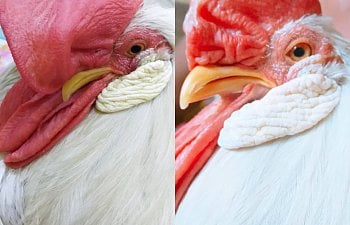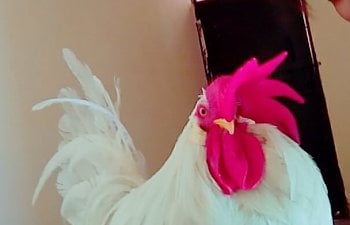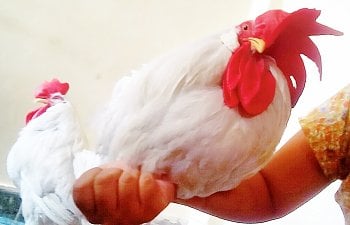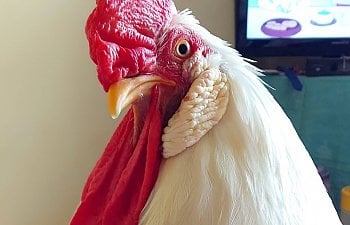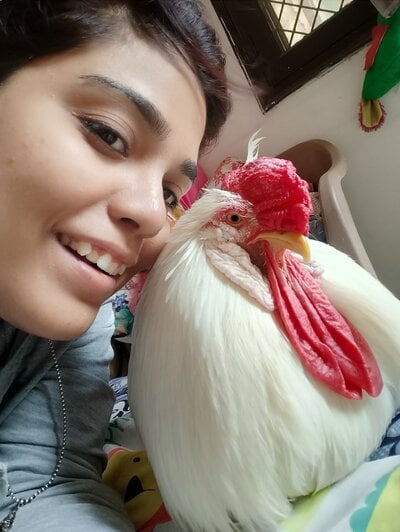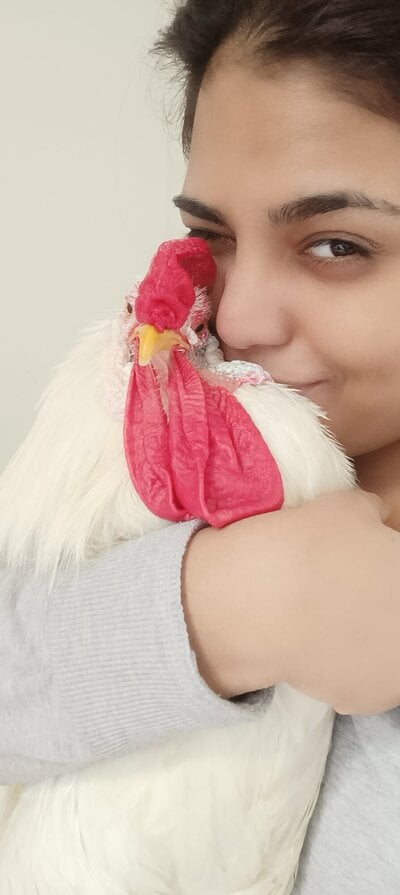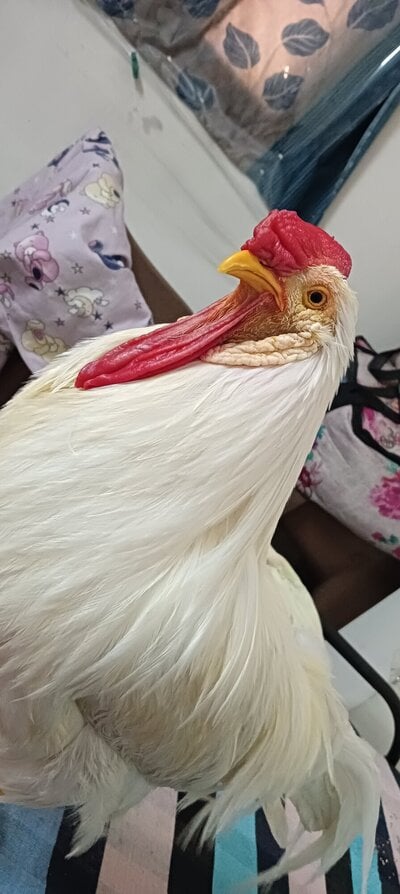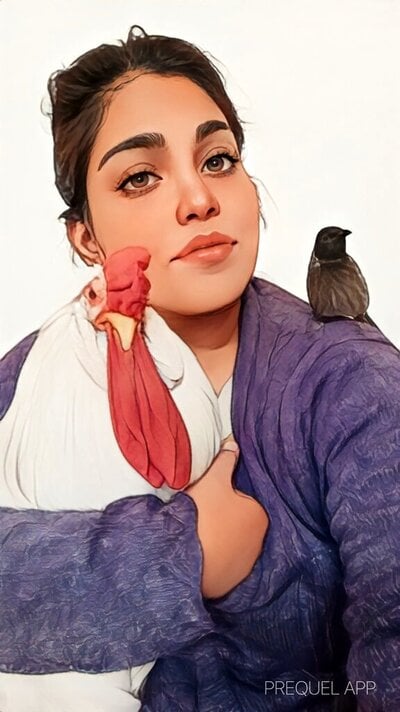Hello everyone my name is Saaniya Jackson and I'm a owner of my two beautiful roosters namely Tootoo & Teetee
For me these babies aren't chickens I raised them like my own kid
Since the day I bring tootoo teetee home . Tootoo always have a good growth then teetee , He always a active , fast chick! .. and his comb grows faster then him . I notice a cute small Single comb in the 30 days of growth that keeps growing and growing until the age of 6 months . His comb was bigger day by day and heavier , floppy it almost covered his one side of his face .. slowly his neck become curved, he can't eat properly, because the comb keep irritating him . I'm a very good science student and i already know the issue happening with him , I was sure that it creating trouble with his body especially the neck so i started researching over this but because it's a very new case of tootoo's Overgrown comb nothing much i found Google but i find my answers through joining the one by one chain ...
So what is comb? Chicken combs are something that Roosters are known and famous for in India comb is known As Taaj means A King Crown In English ..basically made up from collagen tissue fiber like a rubber band in basic language. Comb contains small veins that supply blood throughout the region and allows Roosters to cool down in Hot Days . Rooster and all chickens can't sweat they don't have sweat gland like humans so Comb act as their Thermostat. When Blood Race through the comb it shows up like a beautiful Red Rose
Comb are also the best indicator of health of rooster anything that happening inside their body affect their comb .
Why comb Grows ? And why tootoo face a huge comb that weigh above 360 grams ?
So i live in New Delhi India a pretty hot city and everyone knows that our region gets too hot and boiling summer so here I found my answers i was looking for ..
I don't have any Air conditioning system in my home . Tootoo Teetee lives with me in open environment where they gets good amount of heat and sun because they grow up in the month of June Which is the peak heaty almost firey summer in new delhi I've got my answer...
Because Of India's 40C temprature and Thermostat work by comb they grow bigger and bigger . Because the comb is doing their work ..cooling the chicken and it's absolutely normal especially when it comes to the breed of tootoo Leghon but tootoo's comb started to build issues with his health .
In health , he can't walk or run
We feed him through hands because he is unable to eat or drink on his own because comb is very heavy .
On Aug 11, 2018 he face Breathing Attack his face ,comb all over body turned blue and unable to breath we give him Breath through Artificial way just like mouth to mouth breath that day was Horrifying .
What is breathing attack?
Comb is located on chickens Head and a small comb is preferable for their small head . Obviously if i put something on my head that weighs more then my body weight it will bent down my neck and i will struggle in my breathing and walking The same thing me and my family assume with tootoo and the day we acrylic realise it was the day he face an attack .
He suddenly started opening his mouth like there's no air circulation in his body , his face and mouth become purple , and he's choking badly until We give him blow of breaths in his mouth until he comes back to his normal state trust me horrifying ..you can't see that situation and i don't want anyone to face it ever that's why i am writing this ..
The comb went all black and there's only 10% chances of his survival if you didn't give round of breaths in his beak and massage his neck . This is known as breathing attack ... Maybe a chocking attack
Pls if u face this give mouth to mouth breath , and open all windows to allow the air flow don't give water until the chicken becomes normal
Once you blow breath in his beak his comb will be back in color like normal and he will be all well then give water to revive but take action fast
Tootoo face almost 5-7 choking attacks in 1 week because every vet i talked about this keep scares me and deny to do this I've no options to save tootoo's life
Picture above taken 3 months before his surgery .
We talked to so many vets in our locality but no one help us in this issues . I was hopeless Because the only way to save his life is Removing His Huge Comb
i love my tootoo more then anything he was my kid and my world..
I stay numb and keep asking , searching and find a solution . This procedure seems only a way to save his life otherwise he will die in choking i can't see that until i try everything .
This is known as Dubbing , Gamebirds keeper use this technique since ages while gameshows of Roosters .This procedure also used to prevent Frostbite where you will remove the comb some portion and help it heal through Roosters Natural healing process
I posted a thread on BYC forum and I got so many positive responses for this comb removal surgery aka. Dubbing
I was all set to do this surgery at any Sake to save my pet's Life .this is the only a way i can save him
A Rooster Comb is made from all Protien fibers they are just like rubber band i told u above . This soft flesh help Thermoregulation so the no 1 reason of extra growth of Comb is High Temperature Heat . ONCE THE Tissue Enabled the growth they start growing Abnormally and build up an abnormal weight on the comb which affect the Rooster Neck , Airway And Eyes but if the comb slightly removed then there's no harmful effects and the thermostat work keep going on and once comb is cut it won't come back like a huge growth
What Is Dubbing??
Dubbing is a procedure used and maybe invent by classic Game Birds owners who use this procedure to showcase their Roosters in games because Comb is a very sensitive part of Roosters Body they use to remove it before performing in games to prevent any serious damage . dubbing also used to prevent Frostbite in cold countries of world . In tootoo's case there's nothing like performing in game or cold environment But the growth of the comb creating Fatal Attacks that causing his life to lead towards end in few seconds if didn't take action.
How Comb Create Issue? Size Matters!
Everyone will say Comb is a Roosters Beauty but few like me who struggles the Cons of the comb say Comb is a dangerous thing for a rooster when it come to Size , weight and length. Check this below
You can clearly able to notice the Comb is covering tootoo's half of his face but it's not just covering his face but also Bent his neck . If you look closely to the diagram of the skeleton you will understand how curved their neck is naturally but when Comb creating pressure on the neck through its weight the neck become more curved and almost pressuring the Airway & Esophageal Area that's why They started developing issues that Mimic like Respiratory issues when tootoo devlop a curved neck the first thing we note is that he can't eat properly, whatever he ate takes time to go down because of his bent neck .
Even Saliva becomes Foamy , thick Slimy
And ofcourse choking attacks
A Normal Chicken Skeleton
Dubbing is only a way to save my tootoo's life because i love him and i don't want him to die in such circumstances he was 1.5 years old the day we dub him and half of the veterinary doctors deny to dub him , So the actions were only in my hands . Thanks to my past science life I know how to proceed in things.
Things we mark as Green Singal for Dubbing Surgery
This is crucial to know that science stays the same , either it's a human or a bird . The terms stays the same so as the check lists before surgery .
• weight should be appropriate for dubbing
Body weight is important because dubbing on a huge comb is a obvious to know that blood loss will be there body weight should be appropriate to handle the aftermath
Tootoo weigh 3 kg the time of surgery his comb weight is 300 grams post removal
• Health & Diet
I live in New Delhi India and we don't have any pellets diet specifically come for poultry. So what i feed is a award winning diet as per @staceyj
I feed my tootoo teetee Pearl Millet (Bajra) , Fresh Corns occasionally, and rest of treats in moderation but Millet stays in their diet as a primary feed . Because pearl millet is very nutritious seeds and they contains everything a chicken body needs still
Side by side their daily dose of suppliment to maintain their Good hemoglobin, body muscles strength , healing power and immunity .
I use Proovi Boost Drops 0.25 ml daily (on 3 kg body weight) it's designed as per Birds too and it's very very good for maintaining health . Tootoo teete Having this since the age of 6 months but if you never give any vitamins to your chickens it's important to give prior 30-60 days before Dubbing to boost the level of hemoglobin as much as u can pls check the label to divide dose as per your bird body weight.
Math Of Dubbing
I ARRANGE EVERY SINGLE STUFF FOR DUBBING I LITERALLY CONVERT MY HALL LIKE A OT ;D
THINGS YOU WILL NEED :
MAIN EQUIPMENT IS A THICK , SHARP KNIFE WITH A GOOD GRIP . (Use Chef Range Knife
Attention: We Did Not Give Any Kind Of Anesthesia Or Numbing Agent Because Anesthesia & Numbing Creams Are Potentially Toxic To Birds , Also Antibiotic Mentioned Below Is Completely Optional We Keep It Just To Be On Safe Side . Tootoo's Comb Heal On Its Own Through Diet & Vitamin Supplements.. Also measure Clotting & Bleeding Time Of Your Rooster By Simply Pricking A sterilize needle on the end of his comb and turn on Timer on your phone to count in many seconds or minutes the blood is forming a clot on his comb . We take the CT-BT by looking at Tootoo's comb scratches his brother teetee use to give him during playing.
Preparations & Stuff :
1.) Antibiotic Baytril Oral Enrofloxacin10%) (Optional)
3) Povidone Iodine Solution To Clean The Comb Before
4) ICE : Ice should be there in huge amount, we had 3 Buckets filled with Ice - Ice Water , Towels Dipped In ICE
5) White Flour & Corn Strach Powder
flour and cornstarch is dubbing main method to stop bleeding and cover the comb in a thick layer to close the wound as well as keep it dry on the location . We can't put ointments on comb open wound because it should be stay dry , away from moisture in order to Heal faster . It takes 3-4 weeks to fall down the scab
PROCEDURE :
THIS IS A 2-3 PERSON PROCEDURE
ONE WILL HOLD THE BIRD , SECOND PERSON WILL CUT THE COMB AND REMOVE IT AND THIRD PERSON WILL STOP THE BLEEDING .
PREPARE A TUB FULL OF ICE AND WATER AND DIP A TOWEL IN THE ICE WATER FOR STOPPING THE BLEEDING
MARK THE COMB WITH MARKER PEN 1 INCH ABOVE FROM ROOT THAT JOINS BACK OF HIS HEAD NEAR SKULL MARK ALL THE EXTRA GROWTH FRONT TO BACK
THEN
HOLD THE BIRD FIRMLY YOU CAN WRAP THE BIRD IN A DAMP TOWEL MAKING MINIMUM NOISES WILL CALM THE BIRD IF YOU SHOUT SCREAM OR TALK LOUDLY THEN BIRD WILL STRESSED.
NOW THE PERSON WHO DECIDED TO CUT COMB HOLD THE COMB FROM ONE HAND AND CUT THE COMB FROM BACK TO FRONT IN A SINGLE STEADY WAY (FASTER HAND)
ONCE U COMB CUT BLEEDING WILL BE ALOT DON'T PANIC!..Its Natural .. Recommend Weather For Dubbing Is WINTER .
REMOVE THE ENTIRE COMB You Marked
And Immediately
APPLY THE ICE DIPPED TOWEL ON THE COMB AND APPLY PRESSURE ON THE BLEEDING FOR 5-10 SECONDS KEEP APPLYING ICE YOU CAN MAKE SOME ICE POWDER AND APPLY DIRECTLY ON THE COMB
LET THE BLEEDING STOP ONCE BLEEDING STOP APPLY FLOUR OR CORN STRACH ON THE COMB AND COVER THE WOUND WITH A THICK LAYER OF FLOUR THEN LEAVE THE COMB AND SETTLE THE BIRD IN A COOL ENVIRONMENT LIKE IN
AIR CONDITIONER THIS WILL STOP THE COMB BLEEDING FLOW .
THERE WILL BE MINOR BLEEDING FOR 23-48 HOURS SO EVERYTIME U SEE SOME BLOOD COMES APPLY FLOUR
LEAVE IT FOR 1-3 WEEK AND IT WILL HEAL ON ITS OWN
POST OP INCLUDE HIGH PROTEIN DIET
BOILED EGG WHITE DAILY ONCE IN MEAL
(NO RICE ,NO YOGHURT THESE STUFF CAN CAUSE INFECTION)
0.25 ml DROPS MULTI-VITAMINS WITHOUT IRON & AMINO ACID DAILY ONCE A DAY
TILL 2-3 MONTH FOR REPLACEMENT OF BLOOD LOSS .
I AM.A HAPPY ROOSTER
Above Pictures I Added That Are From Recent Almost 4 Years After Dubbing
 You Can See How His Comb Now Looking How Beautiful And There's No Growth He Never Face Any Overheat Issue
You Can See How His Comb Now Looking How Beautiful And There's No Growth He Never Face Any Overheat Issue 
